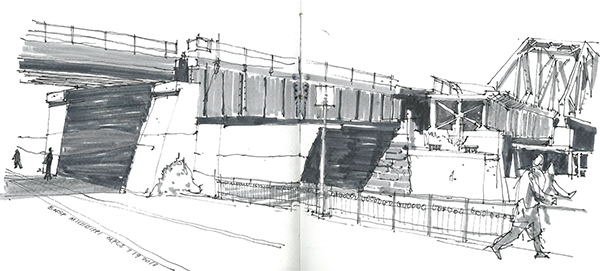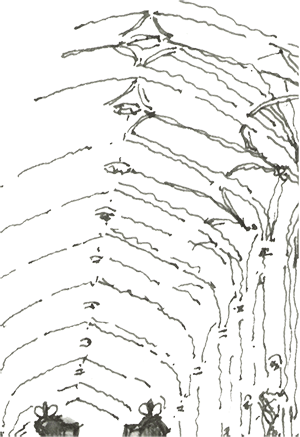
Sometimes a clean line drawing will explain what you’re trying to sketch without the need for color. This might be due to limited time constraints, or simply that the sketch works just as well as a line drawing. I also find that many of my train station and airport sketches—drawings done “on the go”—are without color. I usually travel everywhere with my sketchbook, but I would need to be more organized to have my paints with me. On the whole, though, deciding whether to add color, and if so how much, will come with practice.


SIMONE RIDYARD
Albert Square, Manchester, England
Here’s a sketch from Christmas 2013, drawn on location outside Manchester Town Hall. It’s pretty much a contour drawing, as it’s almost drawn with one continuous line. I went over some lines in a heavier line-weight, and some of the lights were deliberately drawn in a fainter pen. For much of the year this is an empty square, but for the month of December the German Christmas market comes to town, hence the giant Santa figure and strands of Christmas lights. After I’d finished the drawing I wanted to add watercolor but not in “real-time” color.
I used the red of Santa’s costume as my starting point. I chose red watercolor quite intentionally for Santa and the Christmas lights, then complemented this with a cool color (i.e., a couple of shades of blue). There is a bit of warm beige in the mix too, but very much in the background. I wanted the color to enhance the sketch but not compete with the drawing in any way. I also wanted the color to help make sense of the original drawing. so how much, will come with practice.

DANIEL GREEN
BNSF Bridge from Nicollet Island, Mississippi River, Minnesota, USA
This Daniel Green sketch of a bridge (above) works really well tonally, with three or four shades of gray-to-black. The white space of the page plays an important part too, highlighting dark shadows under the bridge in quite a dramatic way. I’d say no color required!

JIM DYSON
King’s College Chapel, Cambridge, England
The sketch above, by architect Jim Dyson, of a church interior is painted in neutral, almost sepia tones, which both help to explain and define the sketch.

There are many different types of vault, from barrel vaults (shallow arches running the length of a ceiling) to rib vaults (often formed at the intersection of two or three barrel vaults), and a vaulted ceiling can seem nearly as complex to sketch as it is to build! The geometry of vaulting is uniform but highly complex, so it can be tricky—especially when drawn in perspective. A good tip is to do your research beforehand. You will find plenty of rules and guidelines online, so with a bit of preparation you can decipher what you’ll be looking at in advance and save yourself a very stiff neck.